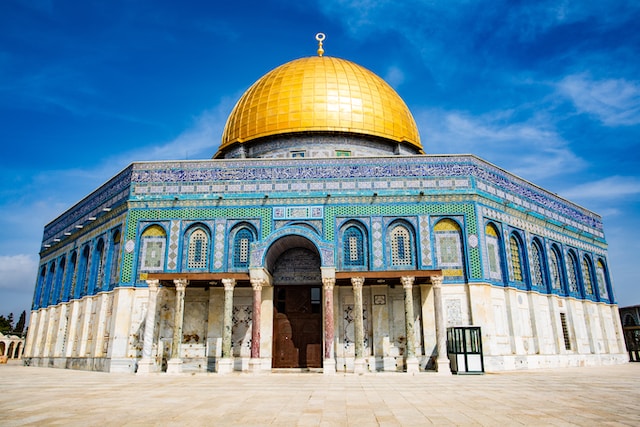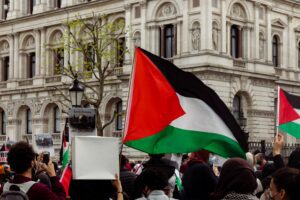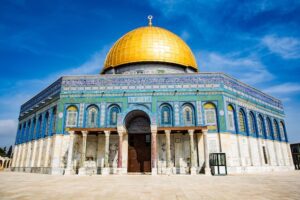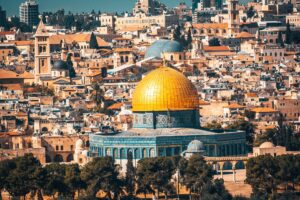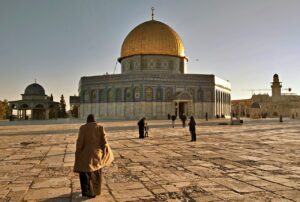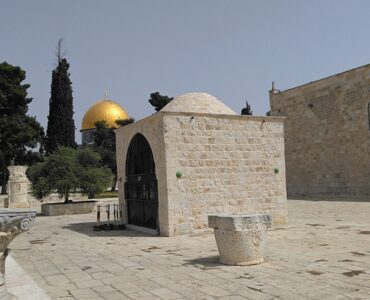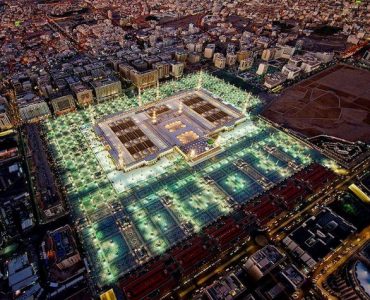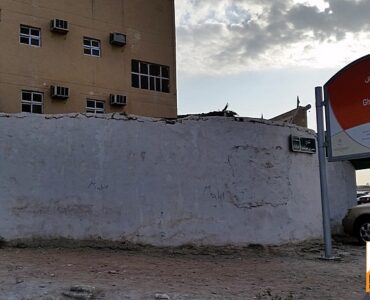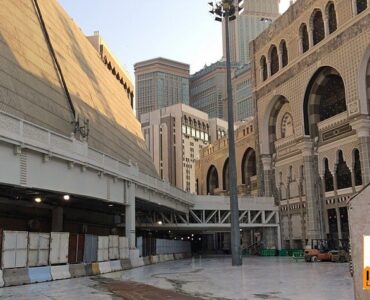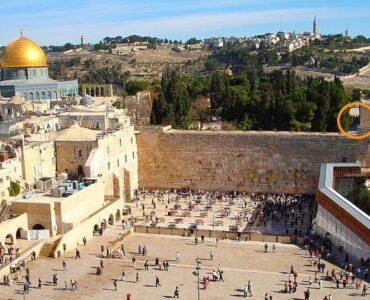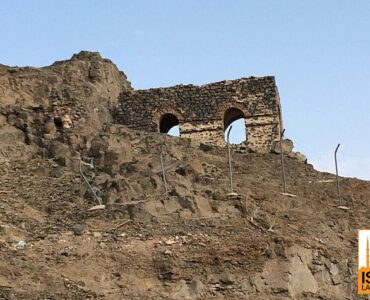Masjid Al Aqsa, a symbol of resistance and monotheism, holds great value in the heart of Muslims worldwide. It is the third holiest mosque in the world and was the first Qibla in Islamic history. Masjid Al Aqsa can be found on the Temple Mount in the Old City of Jerusalem.
Masjid Al Aqsa was an integral part of Miraj – the night Prophet Muhammad (PBUH) ascended to the seven skies. The mosque is associated with important events revolving around the lives of almost all prophets (PBUT) since the beginning of time. Keep reading to learn ten interesting facts about Masjid Al Aqsa.
What Is Masjid Al Aqsa?
Masjid Al Aqsa, also known as the Noble Sanctuary or Al-Haram Al-Sharif, is the third holiest site in Islam after Masjid Al-Haram of Makkah Masjid Al-Nabawi of Madinah. The mosque is built on Temple Mount and has great importance not only in the religion of Islam but in Christianity and Judaism as well.
What Is Special about Masjid Al Aqsa to Muslims in Islam?
Masjid Al Aqsa was the first Qibla in Islam and an important destination of Prophet Muhammad (PBUH) during Miraj. Allah SWT speaking about Miraj (Night Journey and Ascension) in the Holy Quran, says, “Exalted is He who took His Servant by night from al-Masjid al-Haram to al-Masjid al-Aqsa, whose surroundings We have blessed, to show him of Our signs. Indeed, He is the All-Hearing, the All-Seeing.” [Holy Quran, 17:1]
Even before Islam, Masjid Al Aqsa was the home of many prophets and was referred to as the centre of monotheism. Bait ul Muqadas is the only mosque except for the Holy Kaaba mentioned in the Holy Quran.
While stating the significance of praying inside Masjid Al Aqsa, the Messenger (PBUH) of Allah SWT said, “A prayer in Makkah (Holy Kabaa) is worth 1000,000 times (reward), a prayer in my Masjid (Madinah) is worth 1,000 times, and a prayer in Al-Aqsa Sanctuary is worth 500 times more reward than anywhere else”. [Tabarani, Suyuti, Bayhaqi]
Abu Hurairah (RA) narrated that the Messenger (PBUH) of Allah SWT said, “Do not undertake a journey to visit any Mosque, but three: this Mosque of mine, the Mosque of al-Haram and the Mosque of Aqsa” [Sahih Muslim 1397]
Brief History on Masjid Al Aqsa
Masjid Al Aqsa has a long and complex history. The mosque has undergone several renovations since its establishment in the 7th century. The architectural structure we see today was originally built by Prophet Ibrahim (AS). The Farthest Mosque was terribly destroyed in the earthquake and was later rebuilt by several rulers of the Ottoman Empire and the government.
During the Crusades, Masjid Al Aqsa was seized by the Christian forces. However, the Muslims succeeded in gaining back their control, restoring the mosque as an important site of worship. Even today, Masjid Al Aqsa is the focal point of many political and religious conflicts between Christians, Jews, and Muslims.
What Does “Al-Aqsa” Mean?
Al-Aqsa is an Arabic word that literally means “The Farthest Mosque” or “The Farthest Sanctuary.” The mosque got its name in light of the event of Miraj when Prophet Muhammad (PBUH) sat on a magnificent creature named the Buraq and went on a trip to the seven skies to meet Allah SWT.
After departing from Masjid Al Haram in Makkah, Buraq brought Prophet Muhammad (PBUH) to Masjid Al Aqsa, where he led the prayer of all prophets.
10 facts about Masjid Al Aqsa
Masjid Al Aqsa is one of the three most venerated mosques in Islam. In this section, we will be discussing ten amazing facts about Masjid Al Aqsa.
Who Built Masjid Al Aqsa?
The foundation of Masjid Al Aqsa was laid by Prophet Adam (AS) and then by Ibrahim (AS), Prophet Ishaq (AS) – the son of Prophet Ibrahim (AS), and lastly, Prophet Sulaiman (AS). However, over the years, the Farthest Mosque was demolished after the conquest of Jerusalem. Later in 705 AD, Abdul Malik ibn Marwan instructed his workers to restore Mosque Al Aqsa on Temple Mount.
In fact, Masjid Al Aqsa was the second mosque to be constructed on Earth. Abu Dharr (RA) reported that he once asked the Prophet Muhammad (PBUH), “O Messenger of Allah, which Masjid was built first on earth”? To which the Prophet Muhammad (PBUH) replied, “The Sacred Masjid of Makkah.” Abu Dharr (RA) again asked, “Which was next”? The Messenger (PBUH) of Allah SWT said, “Masjid Al-Aqsa”.
Abu Dharr (RA) further asked, “How long was the period between the buildings of the two Masjids”? Prophet Muhammad (PBUH) replied, “Forty years.” Apart from these, offer your prayer anywhere when it is time to pray, although excellence is in praying in these Masjids.” [Sahih Al Bukhari]
Which Country Is Masjid Al Aqsa In?
Masjid Al Aqsa is located in the Old City of Jerusalem (East Jerusalem) in the state of Palestine.
The Original Dome of Masjid Al Aqsa Looked Very Different
According to Islamic history, the original dome of Masjid Al Aqsa was constructed by Abdul Malik ibn Marwan, an Umayyad ruler. The first dome was made using wood with brass, lead, and ceramic cover. However, the iconic golden-coloured dome of Masjid Al Aqsa that we all see today was built during the reign of Sulaiman the Magnificent, an Ottoman ruler, thousands of years ago.
He ordered the workers to add Ottoman tiles to the front of the mosque and the distinctive golden layer to the dome. It is also believed that Masjid Al Aqsa’s dome inspired rulers to make the “dome” a staple of Islamic architecture.
How Long Is Masjid Al Aqsa?
Masjid Al Aqsa is 272 ft (83 metres) long and 184 ft (56 metres) wide. The rectangular structure of the Mosque covers 35 acres (14.4 hectares) of land and can hold up to 500,000 worshipers at once.
The Land of Prophets
Every prophet, even those born far away from Masjid Al Aqsa, found their way back to the Qibli Mosque or connected with Bait ul Muqadas in some way. The Messenger (PBUH) of Allah SWT said, “When Prophet Sulaiman (AS) finished building Bait ul Muqadas, he asked Allah SWT for three things: a judgement that was in harmony with His judgment, a dominion that no one after him would have, and that no one should come to this mosque intending to pray there without emerging free of sin as the day his mother bore him.” He added, “Two prayers were granted, and I hope the third was also granted.”
Furthermore, after destroying the idols of Babylon, Prophet Ibrahim (AS) left the city and found himself in the Holy Land of Jerusalem. Allah SWT in the Quran says, “But We delivered him and his nephew Lot and directed them to the Land which We have blessed for the nations.” [Holy Quran, Al Anbiya, 21:71]
Masjid Al Aqsa Was the First Qibla for Salah
Did you know that Muslims didn’t always turn towards the Holy Kaaba while praying for Salah? Masjid Al Aqsa was the first Qibla in the history of Islam and stayed even after 18 months of migration to Madinah.
However, it all changed during Zuhr prayer on 2nd January, 624 CE, when Allah SWT revealed the verse to Prophet Muhammad (PBUH), “Verily, We have seen the turning of your (Muhammad’s) face towards the heaven. Surely, We shall turn you to a Qiblah (prayer direction) that shall please you, so turn your face in the direction of Al-Masjid Al-Haram (at Makkah).” [Holy Quran, 2:144]
After listening to the verse, Prophet Muhammad (PBUH) turned 160 degrees, changing his direction from Masjid Al Aqsa to the Holy Kaaba. Once the prayer was completed, Prophet Muhammad (PBUH) said to the companions that “Even though the Qibla has changed, this does not reduce the importance of Masjid Al-Aqsa to the Muslims.”
Masjid Al Aqsa Is Not Only One Mosque
While we tend to think of Mosque Al Aqsa as a beautiful monument built in the old city of Jerusalem, it is a complex of several mosques, including Buraq Mosque and Marwani Mosque. The Qibli Mosque is situated in the complex’s southern corner.
If you are still confused, know that the compound in which Masjid Al Aqsa is found is called The Noble Sanctuary (Al-Haram Ash-Sharif).
Masjid Al Aqsa Was the Desired Site of Musa (AS)
Abu Hurairah (RA) reports that the Prophet Muhammad (PBUH) said, “The Angel of death was sent to Musa (AS). When he came to Musa, Musa punched him in the eye. The Angel returned to Allah, saying, ‘You sent me to a servant who does not want to die.’ Allah ordered the Angel, ‘Return to him and tell him to put his hand on the back of an ox and for every hair that will come under it, he will be granted one year of life.’ Musa asked, ‘O Lord! What will happen after that?’
Allah replied, ‘Then death.’ Musa decided to let it be now. Musa then requested Allah to let him die close to the Sacred Land (near Masjid Al-Aqsa), so much so that he would be at a distance of a stone’s throw from it.” Abu Hurairah (RA) added that the Prophet Muhammad (PBUH) then said, “If I were there, I would show you his grave below the red sand hill on the side of the road.” [Sahih Bukhari]
The Complex of Masjid Al Aqsa Is Also a Burial Ground
While there is no accurate information on how many graves can be found in Al-Haram as-Sharif, we know for sure that it is the resting place of many prophets and companions, including Sulaiman (RA) and Ubadah ibn Samir (RA).
The Reward of Donating to Masjid Al Aqsa
Another way of earning a great reward is by donating to Masjid Al Aqsa as much as possible. Maymunah bint Sa’d (RA) narrated that she once asked the Prophet Muhammad (PBUH), “O Prophet (PBUH), Inform us about Bayt al-Maqdis.” He said, “Visit it for prayer.”
She further asked, “If one of us cannot visit it, what shall we do?” He (PBUH) said, “If you cannot go for prayer, then send some oil to be used in its lamps; whosoever gives oil for its lamps, it will be as if he has prayed in it.” [Imam Ahmad, Ibn Majah, Sunan Abu Dawud and al-Tabarani]
In another familiar incident, Abdullah Ibn Umar (RA) said, “I asked the Prophet Muhammad (PBUH), ‘Apostle of Allah SWT, tell us the legal injunction about (visiting) Bayt Al-Maqdis (Jerusalem).’ The Messenger (PBUH) of Allah SWT said, ‘Go and pray there. If you cannot visit it and pray there, then send some oil to be used in the lamps.’” [Bukhari]
Pictures of Masjid Al Aqsa
Was Masjid Al Aqsa Built by Jinns?
As stated earlier, Masjid Al Aqsa was first constructed by Prophet Adam (AS), then by Prophet Ibrahim (AS) and stood firm until Prophet Ishaq (AS) passed away. Over time, the foundation of Masjid Al Aqsa weakened and started crumbling. Allah SWT commanded Dawood (AS) to renovate Masjid Al Aqsa once again. However, Dawood (AS) tragically passed away before completing the construction and the project was handed over to his son, Sulaiman (AS).
It is believed that Sulaiman (RA) instructed the Jinns to erect the stone pillars underneath Masjid Al Aqsa. In Surah Saba, Allah SWT says, “There were jinn that worked under his supervision by the leave of his Lord, and if any of them deviated from Our command, We made him taste of the Penalty of Blazing Fire.
They worked for him as he desired, (making) arches, statues, basins as large as reservoirs, and (cooking) cauldrons fixed (in their places): ‘Work, family of Dawud, with thanks! But few of My slaves are grateful!’” [Holy Quran, 34:12-13]
Other masjids in Palestine
Great Mosque of Gaza
Otherwise known as the Great Omari Mosque, the Great Mosque of Gaza is one of the oldest and largest Masjids in the Gaza Strip, Palestine. The site of the Great Mosque of Gaza was originally a Byzantine church. However, it was renovated by the Ottoman Empire. The Great Mosque of Gaza covers an area of 4100 square metres.
Al Siksik Mosque
Situated in the city of Jaffa, Israel, the Al Siksik Mosque was constructed by the prominent Siksik family in the 1880s. Hajj Abd al-Qadir al-Siksik was the founder of the mosque. Al Siksik Mosque is the second Masjid to be built outside the walls of Jaffa. In 1919, Al Siksik Mosque was no longer being used as a place of worship and was transformed into a café in 1948, which was later closed.
White Mosque
White Mosque is situated in Ramle, Israel/Palestine. Constructed in the 18th century during the reign of Caliph Suleiman bin Abd al-Malik, the White Mosque is an ancient Umayyad-era Masjid. The rectangular mosque was built using white marble and is 93 metres in length and 84 metres in width. However, the White Mosque was destroyed in an earthquake in 1034, and all that’s left is a large square minaret.
Summary – Facts about Masjid Al Aqsa
Featuring four minarets, a gleaming golden dome, a beautiful façade of blue tiles, and seventeen gates, Masjid Al Aqsa is located in the old city of Jerusalem. Also known as The Farthest Mosque, it holds great historical and religious significance in Islam and is known for its unique attributes. Masjid Al Aqsa is the only mosque after the Holy Kaaba that is mentioned in the Holy Quran.

